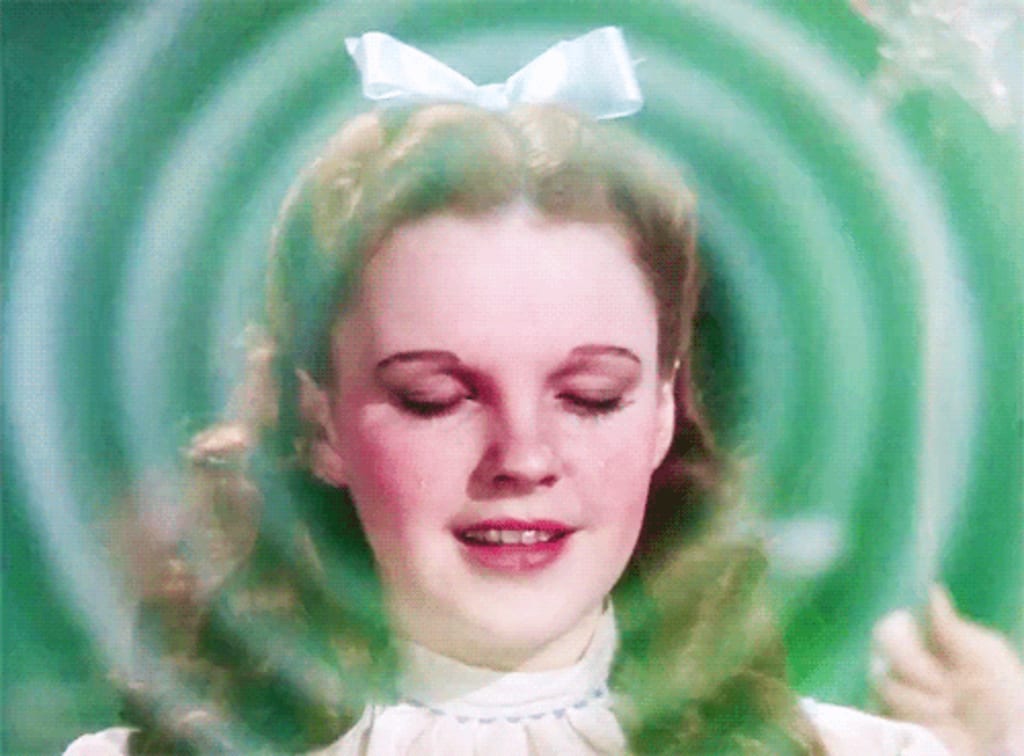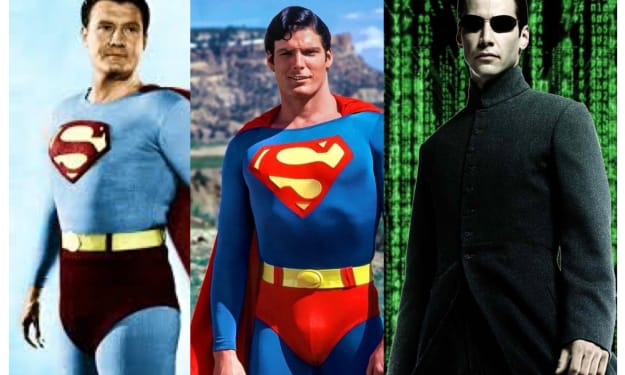
The Yellow Flick Road: Time Travel
While I am fully aware that The Wizard of Oz is “technically” not a movie about time travel, my own delusion has once again influenced my belief system. But spacetime is a thing, and traveling through space is a thing, and space and time are intrinsically linked. All movies travel through through time, so all movies are about time travel. But let’s be reasonable. We will focus on movies that deliberately discuss abnormal temporal activity.
Roadtrip!
To talk about time travel, embrace the concept that every theory about time travel is right – at least, the time travel introduced in every film is right. Yes, they contradict one another, but they all are right from their own perspective. (Obi-Wan: It’s the truth from a certain point of view) But if we use The Wizard of Oz as our template, we can make sense of every film that involves time travel.
As of this writing, the imdb lists 771 films that involve time travel.i But not all time travel is the same. While the variables are great, we will focus on four archetypes for the rules of time travel:
1. The Butterfly Effect: You go into the past, you change your future. You can kill yourself by killing your ancestor, or the Nazis are in charge because you didn’t save Private Ryan. The best example of this is Back to the Future, where realtime changes occur as you make alterations in the past. Of course, Looper, Jumanji, X-Men: Days of Future Past and the Terminator films fall into this archetype.
2. A variation on the Butterfly Effect is called a time loop, that is, an event or a period of time continues to repeat until some specific action from a character affected is taken. Breaking the loop is one outcome, expertly demonstrated by Groundhog Day, and further refined in Edge of Tomorrow. The other outcome is continuous looping, which is what occurs in Twelve Monkeys.
3. The Retcon: You go into the past, you create or enter an alternate timeline. Avengers: Endgame went out of its way to illustrate this theory, and does well (the old Captain America is a bit of a gnawing point, but we’ll move on), but I believe J.J. Abrams Star Trek does it better. This form of time travel was made popular by DC’s Crisis on Infinite Earths series back in the 1980s, when their universe and the stories their writers were creating began hitting some serious continuity walls.
4. No Consequences: You go into the past, it has no effect whatsoever. Time Bandits and Army of Darkness are the best examples of this archetype. Deadpool 2 notwithstanding, this is the least scientific and in some ways the most fun.
But honestly? The only film (or films) we need to discuss about time travel is The Back to the Future trilogy, which covers all four archetypes.
The Back to the Future Trilogy
Back to the Future was the highest grossing film of 1985, starring Michael J. Fox, Christopher Lloyd, Crispen Glover and Lea Thompson. It was written by Robert Zemekis and Bob Gale, Gale being the last name of Dorothy in The Wizard of Oz drops mike. Back to the Future is the template for all time travel movies that exist before and after it.
The film begins at 7:53am, as reflected by the several clocks we see. A Rube Goldberg alarm clock is initiated, and we can see immediately tell that something is wrong as it malfunctions while we hear a news report discuss the theft of plutonium. Marty McFly, our Dorothy (notice his name suggests air, like Gale, or Skywalker, maybe?) enters, notices nothing, and proceeds to plug his electric guitar into the largest amplifier anyone had ever seen to that point, and proves that soundwaves can kill. It establishes several things: science is real, teenagers are reckless, and that Marty is a genius. Marty gets a call from Doc Brown, who gives Marty ominous instructions regarding time, and our second hint of time travel presented when we discover the story starts 20 minutes into the future, as all the clocks are set twenty minutes too fast.
Marty McFly is talented and misunderstood protagonist. Like Liam Neeson, he has a particular set of skills. One of them is space travel, as he is able to travel to his school rather quickly using just his intellect and a skateboard.
We are introduced to Hill Valley, an oxymoron, the town that the trilogy is set in. Like Kansas, like Tatooine, a place with no color and no apparent future. We meet Jennifer, Marty’s love interest, but like the Scarecrow, she is underdeveloped.
Establishing reality before time travelers
(Continue to use Back to the Future Part Two imagery.) As our story is introduced, we see the world function as if time travel doesn’t exist, to give us a baseline of what to expect, and then that is flipped on its head by the actions of the time traveler or travelers. The effects of the time travel is presented to us cinematically; we have to know something unusual has happened. In The Wizard of Oz, we are introduced to our cast, and warned of the reality altering effects of a twister, in this case our means of temporal transportation. Dorothy awakes after a blow to the head, goes to her front door to discover a vibrant new world. She leaves Kansas, a sepia toned static futurepresent and enters Oz, a technicolor futurepast. She also discovers she has committed manslaughter. Her actions completely changed the Land of Oz immediately. The longer Dorothy is in Oz, the more changes she makes. When all the desired alterations have occurred, that is when Glinda steps in and sends Dorothy Back to the Future. Present. Oddly, when Dorothy does return, she possesses all the memories of her excursion, but her colleagues have not noticed any change. This suggests that The Wizard of OZ is both a Butterfly Effect and No Consequences. The Butterfly effect occurring only in the Ozian futurepast, and No Consequences in the Kansasian futurepresent.
Bill and Ted establish this reality shift whenever they enter the phone booth and emerge in another era.
Movies based on Mark Twain’s classic A Connecticut Yankee in King Arthur’s Court or H. G. Wells’ The Time Machine establish this dichotomy as well. We as viewers are shown quite clearly diametrically opposed visions of reality to constantly remind us the oddness of it all. Movies based on the Rip van Winkle premise, such as Demolition Man or Captain America: The First Avenger or Austin Powers fall into this category as well.
A curious wrinkle to reality shifting is Charles Dickens’ A Christmas Carol, which allows for Ebenezer Scrooge to observe the past, but not change it, observe the present, but not change it, observe the future and then given the option of returning to the present to change the future. This remote sensing is set up in The Wizard of Oz when Dorothy looks into The Wicked Witch’s crystal ball and sees her Auntie Em in the futurepresent, wondering where Dorothy is. A wrinkle to that is Frank Capra’s It’s a Wonderful Life, where George is made the butterfly removed from history. This is also the premise of Back to the Future Part Two, when Biff’s actions radically alter the timeline, after he uses information from the future to alter his his own future, which has ramifications to the entire future.
Adventures in Time: Back to the Future – Part Three
After Dorothy emerges from her monochromatic abode, things get a little weird. There are so many movies that give us this moment throughout history, but let’s focus on the time travel ones. Clearly we are not in Kansas anymore. First consequence? The death of the Wicked Witch of the East, which presents Dorothy with William Munny treatment (Unforgiven). The Munchkins’s reaction to Dorothy is a clear sign to how alien she is to this reality/fantasy/dimension/timeline.
It is the fish out of the water (Aquaman?!?) trope that is used, and yet after her initial shock (Are you shocked, Mr. Williams? *scoffs* Only at how sloppy your man works) Dorothy recovers rather beautifully (It really was no miracle). The Munny treatment aforementioned takes the shape of The Lullaby League and the form of the Lollipop Guild. (Wonder Twin powers activate) Then an authority figure authenticates the homicide. Then a celebration of the demise. Thus the first slasher film is born, with Dorothy as the killer.
Back to time travel. Dorothy is out of this world, and needs a way back, and can see no clear path, so she needs the advice of someone more knowledgeable, in this case, The Wizard. The Wizard manifests in many different ways in time travel movies. Doc Brown is the clear choice, although he is presented as both the Wicked Witch of the East and the Wizard in the First Back to the Future, because technically there are two different characters, even if they are the same person. In the Terminator films, we are given the bad news that time travel is a one way street, and there is no way back home. In the first Terminator, Dorothy is Sarah Connor, who never leaves Oz. Instead, the Scarecrow, Kyle Reese, comes to her. (show the love scene. Feel awkward.)
Takeaways
When you reverse time, there are no consequences. Superman does that without explaining the only change made was bringing Lois back to life, although we clearly see Superman reversing the rotation of the earth. Christopher Reeves’ Superman is omnipotent; I cannot understand how he struggles against ANYTHING. I would be interested to see the movie about the vast changes Superman made to the spacetime continuum after reversing time to save Lois.
The same thing happens in The Matrix Reloaded when Neo dreams a premonition of Trinity’s death, prevents that death and brings her back but it does nothing to prevent the inevitable destruction of Zion and the rebooting of the Matrix and also concurrently the Smith virus rewriting everyone. Keanu Reeves’ Superman is omnipotent; I cannot understand how he struggles against ANYTHING. You should watch or read my article on the Three Supermans: Reeves, Reeve and Reeves: A Superman Story.
When you go forward in time, there are no consequences. It is the direction everything is going in to begin with; now you’re going faster. The only consequence is to the time traveler.
Doctor Strange is another time travel movie that touches on all aforementioned archetypes.
But when you look into the future, there are consequences. Does what you know allow you to change the future, or does it cause the event to happen? I think Back to the Future Part 2 explains this the best by showing us how The Retcon actually works. If you receive information from the future, you can use that information to create an alternate timeline. T2, Timecop, and the Netflix original series Continuum and Travelers illustrate this. However, If you see the future during the present, those eventualities are harder to change. Minority Report displays this well.
Want to watch a movie on time travel? Here's a list:
Back to the Future Trilogy (1985, 1989, 1990)
Terminator (1984, 1991, 2003, 2009, 2015, 2019)
The Time Traveler’s Wife (2009)
Donnie Darko (2001)
It’s a Wonderful Life (1946)
A Christmas Carol (2009)
The Muppet Christmas Carol (1992)
About Time (2013)
Looper (2012)
Men in Black 3 (2012)
Galaxy Quest (1999)
Hot Tub Time Machine (2010)
Star Trek: First Contact (1996)
Frequency (2000)
Pleasantville (1998)
Deja Vu (2006)
Peggy Sue Got Married (1986)
Minority Report
Austin Powers: The Spy Who Shagged Me (1999)
Austin Powers in Goldmember (2002)
Timecop (1994)
The Butterfly Effect (2004)
Yesterday (2018)
The Girl Whp Leapt Through Time (2006)
A Sound of Thunder (2005)
The Kid (2000)
Interstellar (2014)
X-Men: Days of Future Past (2014)
Freebirds (2013)
Time Loop
12 Monkeys (1995)
Groundhog Day (1993)
Edge of Tomorrow (2014)
Source Code (2011)
Premonition (2007)
Timequest (2000)
The Umbrella Academy (2018)
Star Trek (2009)
Avengers: EndGame (2019)
The Last Temptation of Christ
Land of the Lost (2009)
X-Men: First Class
Terminator: Genysis (2015)
Sliding Doors (1998)
The One (2001)
No Consequences
Bill & Ted’s Excellent Adventure & Bogus Journey (1989, 1991)
Army of Darkness (1992)
A Connecticut Yankee in King Arthur’s Court (1921, 1948, 1970, 1989)
Black Knight (2001)
The Time Machine (1960, 2002)
Planet of the Apes (1968)
Time Bandits (1981)
Midnight in Paris (2011)
Harry Potter and the Prisoner of Azkaban (2004)
Superman (1978)
Prince of Persia: The Sands of Time (2010)
Time After Time (1979)
Star Trek IV: The Voyage Home (1986)
The Philadelphia Experiment (1984)
Captain America: The First Avenger (2011)
Demolition Man (1993)
Somewhere in Time (1980)
The Lake House (2006)
Idiocracy (2006)
Click (2006)
13 Going on 30 (2004)
Big (1988)
Timeline (2003)
Kate & Leopold (2001)
Filed of Dreams (1989)
Warlock (1989)
Freejack (1992)
About the Creator
Antonio Jacobs
A lifelong New Yorker, Antonio writes fiction and non-fiction and is a musicologist who believes that The Wizard of Oz is the template for all films ever made.






Comments
There are no comments for this story
Be the first to respond and start the conversation.